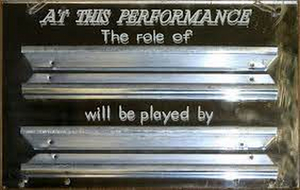Student Blog: A Word About Swings, Standbys, and Understudies
A few reminders about who swings, standbys, and understudies really are, and why they deserve endless respect.
 In light of the recent surges of public appreciation for standbys, understudies, and swings on Broadway, plenty of theatre artists have discussed their vital importance in a show (I mean, shows can't happen without them), but not many have discussed why it's important to quash the idea of these performers being "less than" the performers in principal roles and why there is no reason to be comparing a swing, understudy, or standby to the performer for whom they're covering.
In light of the recent surges of public appreciation for standbys, understudies, and swings on Broadway, plenty of theatre artists have discussed their vital importance in a show (I mean, shows can't happen without them), but not many have discussed why it's important to quash the idea of these performers being "less than" the performers in principal roles and why there is no reason to be comparing a swing, understudy, or standby to the performer for whom they're covering.
One could say, "But the understudy I saw in such-and-such a show had to lower the key of their eleven-o-clock number!" or "They don't play this role the way the main person does!" and proceed to use this as reasoning for why they believe the understudy "isn't as good." At this, let's stop for a second and ask two questions.
First question: What is theatre? Theatre is an art.
Second question: Does art have right or wrong, good or bad? No, art is subjective.
A piece of theatre is created by many different minds, from writers to dramaturgs to directors to actors to scenic designers to everything in between. The goal of creating a piece of theatre is to invoke feelings from an audience and to tell them a story. An actor's task is to tell their character's story to their audience, and how they interpret their character's story is up to them, their director, and their writers. How their interpretation is received is all dependent upon an audience and how audience members perceive the overall show. Any character, just like anyone in real life, is multifaceted, and different actors will reveal some different facets of their character. All actors are still hardworking and talented artists, and their role in a project is a mark of where they fit in that project, not a permanent mark of their talent.
"But if the understudy is so good, why aren't they a big name?" some ask when discussing Broadway understudies. The answer is that if you are a Broadway actor, you are clearly talented and a hard worker, and just because someone's name isn't as big doesn't make them less talented, it just means that their path as a performer is different. Again, art is subjective, and all performers receive a different amount of opportunities based on whatever each project they audition for is seeking. Patti LuPone's Broadway understudies, standbys, and the swings in her shows may not be Patti LuPone, but they're still Broadway actors.
At the end of the day, the most important lesson to learn is that standbys, understudies, and swings are every bit as much of an artist as their show's lead actor. All actors, at the end of the day, are part of an ensemble, and each actor is equally vital in performing the piece. Think of a show as a neighbour's garden- you might notice the bigger and brightly colored flowers first, while looking at it, but the smaller and greener vegetable plants are still on the same soil, under the same sun and taking the same water, and it takes all of these plants together to make the garden the envy of the neighborhood.
Videos
.png)
